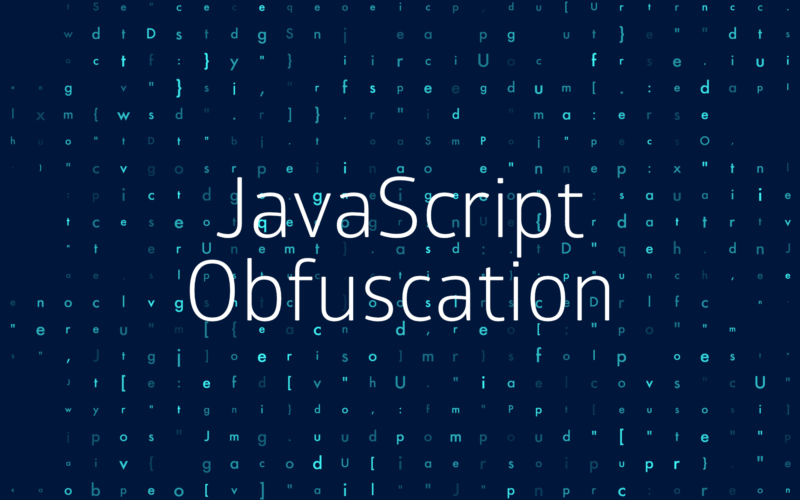Find out all you need to know about code obfuscation techniques and how to choose the right obfuscation tool for protecting your app in this guide.
What is obfuscation?
In everyday language, obfuscation simply describes the process of making something difficult to understand. In the context of software development, code obfuscation carries a similar connotation—it's a method of modifying an application's source code to make it challenging for attackers to read or comprehend, while maintaining its original functionality.
Protecting your code from prying eyes and malicious intent is paramount. Imagine a world where your groundbreaking algorithms and sensitive user data are laid bare for anyone to see and manipulate—the consequences could be devastating.
New to code obfuscation? Find out more about how you can protect your business and intellectual property from reverse engineering in our beginner’s guide to app code obfuscation.
According to a report by Fortune Business Insights, the global application security market size was valued at USD 8.86 billion in 2022 and is projected to grow from USD 9.95 billion in 2023 to USD 25.30 billion by 2030 at a CAGR of 14.3%. This growth is fueled by the increasing demand for secure software applications and the critical need to safeguard sensitive data from falling into the wrong hands.
The mobile app development landscape, in particular, has become a breeding ground for threats, with numerous tools available for attackers to hook into proprietary software, reverse-engineer apps, identify weaknesses, and exfiltrate sensitive information. This is where code obfuscation comes into play, acting as a powerful deterrent to obscure the logic and purpose of your app's code.
By implementing code obfuscation, you can fortify your apps against a wide range of risks, including:
- Intellectual property theft
- Unauthorized access to sensitive data
- Revenue loss due to app piracy or tampering
- Reputational damage resulting from security breaches
- Regulatory compliance violations
This guide delves into the intricacies of code obfuscation, exploring its various techniques, best practices, and real-world applications.
Common obfuscation techniques
Code obfuscation is a multifaceted approach to application security, employing a diverse array of techniques that target different aspects of the source code.
Understanding how these techniques differ from encryption is important. While obfuscation makes code difficult to understand and reverse engineer, encryption converts sensitive data into a secret code to prevent unauthorized access. These complementary measures protect both your intellectual property and your app's data.
Let’s take a look at some of the most common obfuscation techniques.
Name obfuscation
Name obfuscation, also known as renaming, is a fundamental technique that involves replacing the meaningful names of classes, methods, and variables with less descriptive or random names. By stripping away the semantic context, name obfuscation makes it significantly harder for an attacker to understand the purpose and functionality of each code element.
Imagine a method named validateCreditCard that holds the key to your app's secure payment processing. By renaming it to something obscure like m1, you can effectively mask its true identity, making it far more challenging for an attacker to locate and exploit any potential vulnerabilities.
Control flow obfuscation
Control flow obfuscation is a powerful technique that alters the structure of your code's execution path without modifying its underlying functionality. By reshaping the logical flow of your program, control flow obfuscation makes it exceptionally difficult for attackers to trace and comprehend the sequence of operations.
One popular approach to control flow obfuscation is control flow flattening. This technique dismantles the original flow of the program and replaces it with a dispatcher that dynamically determines the execution order. By obscuring the relationships between code blocks, control flow flattening creates a complex web of execution paths that are incredibly challenging to untangle.
Data obfuscation
Data obfuscation focuses on protecting the crown jewels of your application: sensitive data. By encoding, encrypting, or transforming critical information, data obfuscation renders it unreadable to unauthorized parties, even if they manage to breach other defenses and gain access to portions of your code.
Imagine a scenario where your app handles highly confidential user data, such as financial records or personal identification numbers. By employing data obfuscation techniques, you can ensure that this sensitive information remains indecipherable to attackers, even if they successfully reverse-engineer parts of your code.
White-box cryptography
White-box cryptography is a specialized form of obfuscation that focuses on protecting the integrity of cryptographic operations within your application. By implementing cryptographic algorithms in a way that makes it extraordinarily difficult for attackers to extract keys or understand the underlying logic, white-box cryptography ensures the secrecy of your app's most sensitive components.
Additional considerations: Runtime protection and tamper detection
While code obfuscation lays a strong foundation for application security, it is essential to reinforce your defenses with additional measures. Anti-debugging and anti-tampering controls play a vital role in detecting and responding to runtime threats, like the presence of debuggers, emulators, or modified code.
Obfuscation in practice
Let's explore how obfuscation is applied in various development contexts:
Web development: Protecting JavaScript code
In the world of web development, JavaScript reigns supreme as the language of interactivity and dynamic user experiences. However, the client-side nature of JavaScript also makes it particularly vulnerable to reverse engineering and tampering attempts. Attackers can easily view and modify JavaScript code, potentially exposing sensitive logic and data.
JavaScript obfuscation emerges as a crucial technique for protecting web applications from such threats. By transforming JavaScript code into an obfuscated form, developers can significantly reduce the readability and comprehensibility of their code, making it far more challenging for attackers to understand and manipulate.
Mobile app development: Securing Android and iOS applications
Mobile app development has exploded in recent years, with Android and iOS dominating the market. However, the widespread adoption of mobile devices has also attracted the attention of malicious actors, who seek to exploit vulnerabilities and steal sensitive information. Code obfuscation plays a vital role in protecting mobile apps from reverse engineering and tampering attempts. Here are some platform-specific considerations:
Android obfuscation
Android apps, typically written in Java or Kotlin, are particularly susceptible to reverse engineering due to the nature of the compiled bytecode format. Attackers can easily decompile Android apps, revealing the underlying source code and potentially exposing sensitive logic and data. To combat these threats, Android developers employ various obfuscation techniques, such as renaming classes, methods, and variables, removing debug information, and applying control flow obfuscation and string encryption.
iOS obfuscation
iOS apps, built using Objective-C or Swift, present a different set of challenges when it comes to code obfuscation. While the compiled machine code of iOS apps is inherently more difficult to reverse engineer compared to Java bytecode, iOS apps are still vulnerable to sophisticated reverse engineering techniques. To fortify iOS apps against such threats, developers employ obfuscation techniques like symbol renaming, string encryption, and control flow obfuscation.
Why you should obfuscate both native and non-native apps
JavaScript
Developing a single hybrid app is quicker and may be more cost-effective than developing native Android and iOS individually. However, hybrid apps can be more vulnerable to attacks than apps written using native languages because JavaScript is easier to reverse engineer and modify because it is typically delivered in a form close to the original source code, unlike compiled native apps.
iOS
Objective-C and Swift are the most common programming languages for iOS apps. Both are compiled to machine code, which makes it more difficult to translate the code back to the original source code. This has created a misconception that iOS apps are hard to reverse engineer. However, the interest in analyzing and understanding machine code is nothing new, and there is a mature technology in place for reverse engineering machine code, based on years of research and expertise in the field.
Android
The Android operating system is hugely popular, and developers are constantly building new apps designed to run on the system. Generally speaking, all mobile code is prone to reverse engineering – but code written in languages that allow dynamic introspection at runtime, such as Java, are particularly at risk.
Other applications of obfuscation
While mobile and web development have been the primary focus of our discussion thus far, code obfuscation's applicability extends far beyond these domains. Desktop applications, firmware, and embedded systems can all benefit from the protection offered by obfuscation techniques.
Choosing and evaluating obfuscation tools
With a plethora of obfuscation tools available in the market, selecting the right one for your project can be a daunting task. However, by considering a few key factors, you can streamline your decision-making process and choose a tool that aligns with your specific needs and requirements.
Language and platform compatibility
The first and foremost consideration when selecting an obfuscation tool is its compatibility with your development language and target platform. Whether you're building apps for Android, iOS, web, or desktop, ensure that the tool you choose supports the programming languages and frameworks you work with.
Comprehensive obfuscation techniques
An effective obfuscation tool should offer a comprehensive set of obfuscation techniques to provide maximum protection for your code. Look for tools that support a combination of name obfuscation, control flow obfuscation, string encryption, and other advanced techniques.
Performance impact and overhead
Obfuscation techniques, while crucial for code protection, can sometimes come at the cost of increased app size and slower execution speeds. When evaluating obfuscation tools, it's essential to consider their impact on your application's performance.
Integration and ease of use
The integration process and ease of use are critical factors to consider when selecting an obfuscation tool. Look for tools that seamlessly integrate with your existing development workflow and build processes, without requiring extensive setup or configuration.
Reliability and vendor support
When entrusting the security of your application to an obfuscation tool, it's crucial to choose a reliable vendor that provides robust support and ongoing updates. Look for vendors with a proven track record of delivering high-quality obfuscation solutions and excellent customer support.
Obfuscation best practices and security considerations
Obfuscation as part of a layered approach
While code obfuscation is a powerful technique for deterring reverse engineering attempts, it is not a silver bullet. Determined attackers with sufficient time, resources, and expertise may still be able to deobfuscate parts of the code. Therefore, adopting a layered security approach is crucial for safeguarding your application from a wide range of threats. Code obfuscation should be complemented with additional security measures, such as:
- Encryption: Protect sensitive data at rest and in transit by employing strong encryption algorithms and secure communication protocols.
- Runtime application self-protection (RASP): Implement RASP techniques to detect and respond to runtime attacks, such as code injection and tampering attempts.
- Secure coding practices: Follow secure coding guidelines and perform regular code reviews to identify and remediate vulnerabilities in your application's codebase.
By combining code obfuscation with these additional security measures, you can create a comprehensive defense-in-depth strategy that minimizes the risk of successful attacks and data breaches.
Another factor to consider is artificial intelligence as a deobfuscator. While there are still limits to it, the fight between those who’d use AI to protect their code and those who’d use it to steal has already started.
Potential drawbacks of obfuscation
While obfuscation is a powerful technique for protecting your code, it's important to consider its potential impact on performance and maintainability:
- Performance impact: While some obfuscation techniques may slightly increase the size of your application and slow down its execution speed, some obfuscation solutions are carefully designed to strike a balance between strong protection and optimal performance, minimizing any potential overhead.
- Maintainability challenges: Obfuscated code can be more difficult to read and understand, which may impact debugging and maintenance efforts. To mitigate this, maintain a clear separation between the original source code and the obfuscated code, ensuring that the original code remains readable and maintainable for developers.
Despite these potential drawbacks, the benefits of obfuscation far outweigh the costs when it comes to protecting your intellectual property and ensuring your app's security.
Conclusion
Code obfuscation is a crucial technique for protecting software applications from reverse engineering and intellectual property theft. By making the source code difficult to understand and analyze, obfuscation creates an additional layer of defense against potential attackers.
But obfuscation alone is not a silver bullet. It should be combined with other security measures and best practices to create a comprehensive app security strategy. As the threat landscape continues to evolve, it's essential for developers to stay informed about the latest obfuscation techniques and tools to ensure the ongoing protection of their apps.
Find out more about code obfuscation and how you can protect your business and intellectual property from reverse engineering in our beginner’s guide to app code obfuscation.




